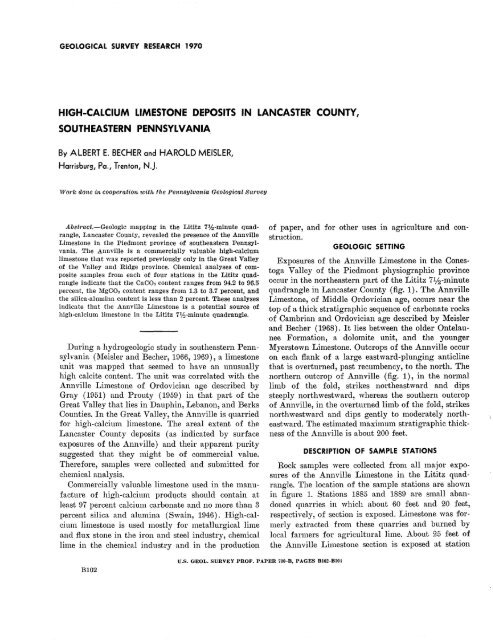RESEARCH· ·1970·
RESEARCH· ·1970·
RESEARCH· ·1970·
You also want an ePaper? Increase the reach of your titles
YUMPU automatically turns print PDFs into web optimized ePapers that Google loves.
GE 1 0LOGICAL SURVEY RESEA·RCH 1970<br />
HIGH-CALCIUM LIMESTONE DEPOSITS IN LANCASTER COUNTY,<br />
SOUTHEASTERN PENNSYLVANIA_<br />
By ALBERT E. BECHER and HAROLD MEISLER/<br />
Harrisburg 1 Pa. 1 Trenton 1 N.J.<br />
Work done in cooperation with, the Pennsylvania Geological Survey<br />
Abstract.-Geologic mapping in the Lititz 7%-minute quadrangle,<br />
Lancaster County, revealed the presence of the Annville<br />
J..~imestone in the Piedmont province of southeastern Pennsylvania.<br />
The Annville is a commercially valuable high-calcium<br />
limestone that was reported previously only in the Great Valley<br />
of the Valley and Ridge province. Chemical analyses of composite<br />
samples from each of four stations in the Lititz quadrangle<br />
indicate that the CaCOa content ranges from 94.2 to 96.5<br />
percent, the l\fgCOo content ranges from 1.3 to 3.7 percent, and<br />
the silica-alumina content is less than 2 percent. These analyses<br />
indicate that the Annville Limestone is a potential source of<br />
high-calcium limestone in the Lititz 7%-minute quadrangle.<br />
During a hydrogeologic study in southeastern Pennsylvania<br />
(:~1eisler and Becher, 1966, 1969), a li1nestone<br />
unit was Inapped that semned to have an unusually<br />
high calcite content. The unit was correlated with the<br />
Annville Limestone of Ordovician age described by<br />
Gray (1951) and Prouty (1959) in that part of the<br />
Great Valley that lies in Dauphin, Lebanon, and Berks<br />
Counties. In the Great Valley, the Annville is quarried<br />
for high-calcium limestone. The areal extent of the<br />
Lancaster County deposits (as indicated by surface<br />
exposures of the Annville) and their apparent purity<br />
suggested that they 1night be of commercial value.<br />
Therefore, samples were collected and submitted for<br />
chemical analysis.<br />
Commercially valuable limestone used in the Inanufacture<br />
of high-calcium prodt}cts should contain at<br />
least 97 percent calcium carbonate and no n1ore than 3<br />
percent silica and alumina (Swain, 1946). High-calcium<br />
limestone is used 1nostly for 1netallurgical li1ne<br />
and flux stone in the iron and steel industry, chemical<br />
lime in the chemical industry and in the production<br />
of paper, and for other uses in agriculture and construction.<br />
GEOLOGIC SETTING<br />
Exposures of the Annville Limestone in the Conestoga<br />
Valley of the Piedmont physiographic province<br />
occur in the northeastern part of the Lititz 71j 2 -minute<br />
quadrangle in Lancaster .County (fig. 1). The Annville<br />
Limestone, of ~1iddle Ordovician age, occurs near the<br />
top of a thick stratigraphic sequence of carbonate rocks<br />
·of Cambrian and Ordovician age described by ~1eisler<br />
and Becher ( 1968). It lies between the older Ontelaunee<br />
Formation, a dolomite unit, and the younger<br />
~1yerstown Limestone. Outcrops of the Annville occur<br />
on each flank of a large eastward-plunging anticline<br />
that is overturned, past recumbency, to the north. The<br />
northern outcrop of Annville (fig. 1), in the nor1nal<br />
limb of the fold, strikes northeastward and dips<br />
steeply northwestward, whereas the southern outcrop<br />
of Annville, in the overturned limb of the fold, strikes<br />
northwestward and dips gently to Inoderately northeastward.<br />
The esti1nated Inaxi1nun1 stratigraphic thickness<br />
of the Annville is about 200 feet.<br />
DESCRIPTION OF SAMPLE STAnONS<br />
Rock sainples were collected frmn all 1najor exposures<br />
of the Annville Liinestone in the Lititz quadrangle.<br />
The location of the sainple stations are shown<br />
in figure 1. Stations 1885 and 1889 are small a bancloned<br />
quarries in which about 60 feet and 20 feet,<br />
respectively, of section is exposed. Limestone was :formerly<br />
extracted frmn these quarries and burned by<br />
local :farmers for agricultural lime. About 25 :feet o:f<br />
the Annville Limestone section is exposed at station<br />
B102<br />
U.S. GEOL. SURVEY PROF. PAPER 700-B, PAGES Bl02-Bl0l
















